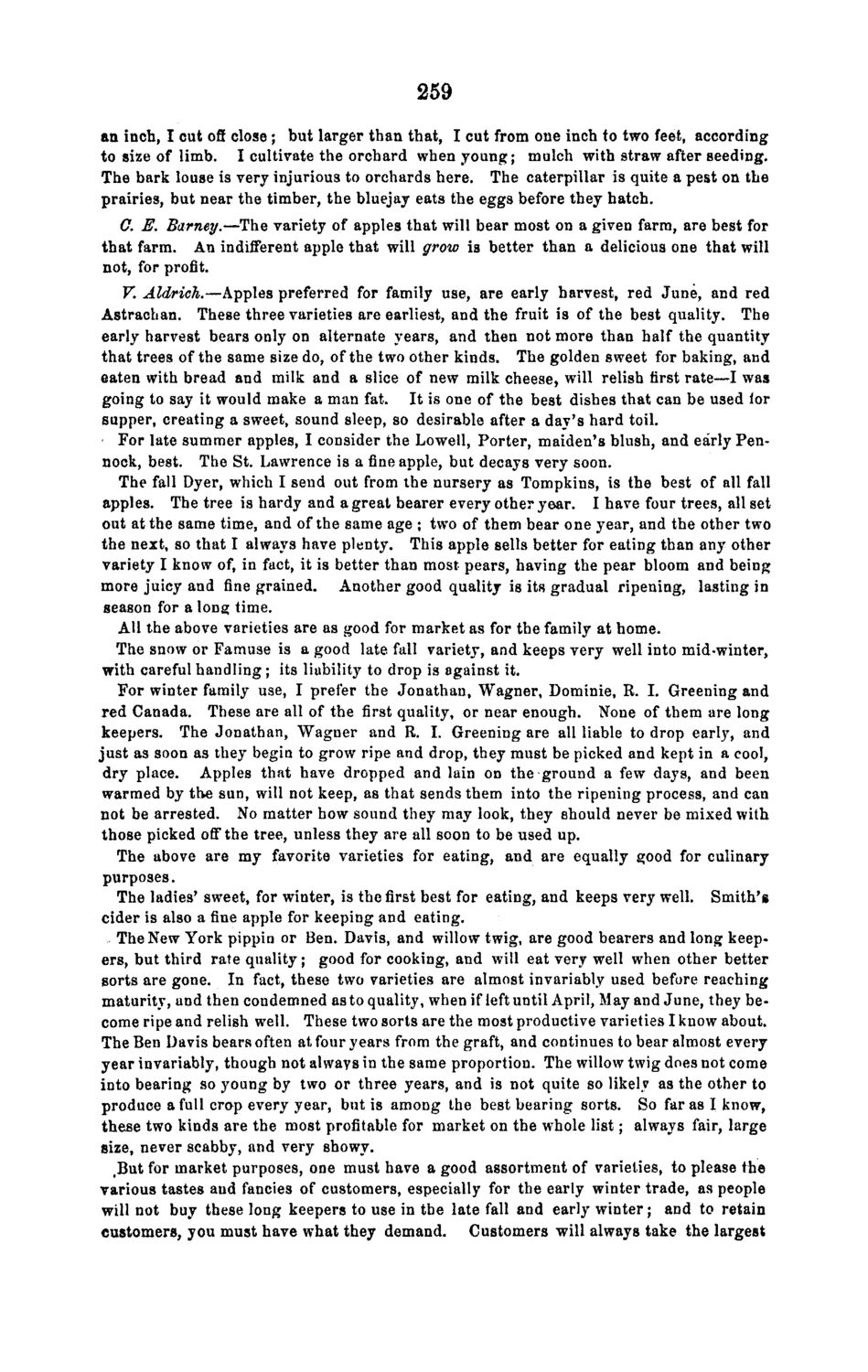| |
| |
Caption: Board of Trustees Minutes - 1868
This is a reduced-resolution page image for fast online browsing.

EXTRACTED TEXT FROM PAGE:
259 an inch, I cut off close; but larger than that, I cut from one inch to two feet, according to size of limb. I cultivate the orchard when young; mulch with straw after seeding. The bark louse is very injurious to orchards here. The caterpillar is quite a pest on the prairies, but near the timber, the bluejay eats the eggs before they hatch. C. E. Barney.—The variety of apples that will bear most on a given farm, are best for that farm. An indifferent apple that will grow is better than a delicious one that will not, for profit. V. Aldrich.—Apples preferred for family use, are early harvest, red June, and red Astrachan. These three varieties are earliest, and the fruit is of the best quality. The early harvest bears only on alternate years, and then not more than half the quantity that trees of the same size do, of the two other kinds. The golden sweet for baking, and eaten with bread and milk and a slice of new milk cheese, will relish first rate—I was going to say it would make a man fat. It is one of the best dishes that can be used for supper, creating a sweet, sound sleep, so desirable after a day's hard toil. For late summer apples, I consider the Lowell, Porter, maiden's blush, and early Pennock, best. The St. Lawrence is afineapple, but decays very soon. The fall Dyer, which I send out from the nursery as Tompkins, is the best of all fall apples. The tree is hardy and a great bearer every other year. I have four trees, all set out at the same time, and of the same age ; two of them bear one year, and the other two the next, so that I always have plenty. This apple sells better for eating than any other variety I know of, in fact, it is better than most pears, having the pear bloom and being more juicy and fine grained. Another good quality is its gradual ripening, lasting in season for a long time. All the above varieties are as good for market as for the family at home. The snow or Famuse is a good late fall variety, and keeps very well into mid-winter, with careful handling; its liability to drop is against it. For winter family use, I prefer the Jonathan, Wagner, Dominie, R. I. Greening and red Canada. These are all of the first quality, or near enough. None of them are long keepers. The Jonathan, Wagner and R. I. Greening are all liable to drop early, and just as soon as they begin to grow ripe and drop, they must be picked and kept in a cool, dry place. Apples that have dropped and lain on the ground a few days, and been warmed by the sun, will not keep, as that sends them into the ripening process, and can not be arrested. No matter how sound they may look, they should never be mixed with those picked off the tree, unless they are all soon to be used up. The above are my favorite varieties for eating, and are equally good for culinary purposes. The ladies' sweet, for winter, is the first best for eating, and keeps very well. Smith's cider is also a fine apple for keeping and eating. The New York pippin or Ben. Davis, and willow twig, are good bearers and long keepers, but third rate quality; good for cooking, and will eat very well when other better sorts are gone. In fact, these two varieties are almost invariably used before reaching maturity, and then condemned as to quality, when if left until April, May and June, they become ripe and relish well. These two sorts are the most productive varieties I know about. The Ben Davis bears often at four years from the graft, and continues to bear almost every year invariably, though not always in the same proportion. The willow twig does not come into bearing so young by two or three years, and is not quite so likely as the other to produce a full crop every year, but is among the best bearing sorts. So far as I know, these two kinds are the most profitable for market on the whole list; always fair, large size, never scabby, and very showy. ,But for market purposes, one must have a good assortment of varieties, to please the various tastes aud fancies of customers, especially for the early winter trade, as people will not buy these long keepers to use in the late fall and early winter; and to retain customers, you must have what they demand. Customers will always take the largest
| |